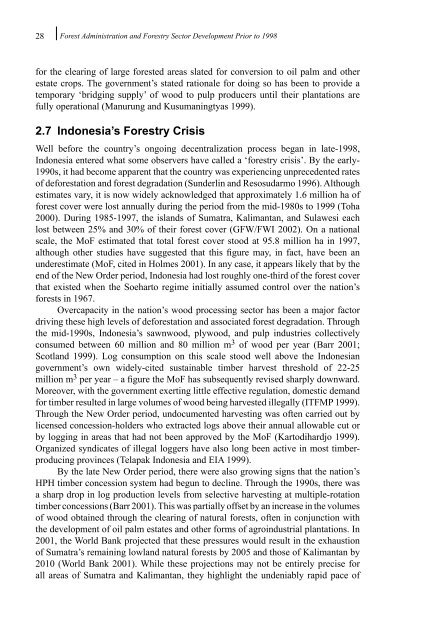Decentralization of Forest Administration in Indonesia, Implications ...
Decentralization of Forest Administration in Indonesia, Implications ...
Decentralization of Forest Administration in Indonesia, Implications ...
You also want an ePaper? Increase the reach of your titles
YUMPU automatically turns print PDFs into web optimized ePapers that Google loves.
28<br />
<strong>Forest</strong> <strong>Adm<strong>in</strong>istration</strong> and <strong>Forest</strong>ry Sector Development Prior to 1998<br />
for the clear<strong>in</strong>g <strong>of</strong> large forested areas slated for conversion to oil palm and other<br />
estate crops. The government’s stated rationale for do<strong>in</strong>g so has been to provide a<br />
temporary ‘bridg<strong>in</strong>g supply’ <strong>of</strong> wood to pulp producers until their plantations are<br />
fully operational (Manurung and Kusuman<strong>in</strong>gtyas 1999).<br />
2.7 <strong>Indonesia</strong>’s <strong>Forest</strong>ry Crisis<br />
Well before the country’s ongo<strong>in</strong>g decentralization process began <strong>in</strong> late-1998,<br />
<strong>Indonesia</strong> entered what some observers have called a ‘forestry crisis’. By the early-<br />
1990s, it had become apparent that the country was experienc<strong>in</strong>g unprecedented rates<br />
<strong>of</strong> deforestation and forest degradation (Sunderl<strong>in</strong> and Resosudarmo 1996). Although<br />
estimates vary, it is now widely acknowledged that approximately 1.6 million ha <strong>of</strong><br />
forest cover were lost annually dur<strong>in</strong>g the period from the mid-1980s to 1999 (Toha<br />
2000). Dur<strong>in</strong>g 1985-1997, the islands <strong>of</strong> Sumatra, Kalimantan, and Sulawesi each<br />
lost between 25% and 30% <strong>of</strong> their forest cover (GFW/FWI 2002). On a national<br />
scale, the MoF estimated that total forest cover stood at 95.8 million ha <strong>in</strong> 1997,<br />
although other studies have suggested that this figure may, <strong>in</strong> fact, have been an<br />
underestimate (MoF, cited <strong>in</strong> Holmes 2001). In any case, it appears likely that by the<br />
end <strong>of</strong> the New Order period, <strong>Indonesia</strong> had lost roughly one-third <strong>of</strong> the forest cover<br />
that existed when the Soeharto regime <strong>in</strong>itially assumed control over the nation’s<br />
forests <strong>in</strong> 1967.<br />
Overcapacity <strong>in</strong> the nation’s wood process<strong>in</strong>g sector has been a major factor<br />
driv<strong>in</strong>g these high levels <strong>of</strong> deforestation and associated forest degradation. Through<br />
the mid-1990s, <strong>Indonesia</strong>’s sawnwood, plywood, and pulp <strong>in</strong>dustries collectively<br />
consumed between 60 million and 80 million m 3 <strong>of</strong> wood per year (Barr 2001;<br />
Scotland 1999). Log consumption on this scale stood well above the <strong>Indonesia</strong>n<br />
government’s own widely-cited susta<strong>in</strong>able timber harvest threshold <strong>of</strong> 22-25<br />
million m 3 per year – a figure the MoF has subsequently revised sharply downward.<br />
Moreover, with the government exert<strong>in</strong>g little effective regulation, domestic demand<br />
for timber resulted <strong>in</strong> large volumes <strong>of</strong> wood be<strong>in</strong>g harvested illegally (ITFMP 1999).<br />
Through the New Order period, undocumented harvest<strong>in</strong>g was <strong>of</strong>ten carried out by<br />
licensed concession-holders who extracted logs above their annual allowable cut or<br />
by logg<strong>in</strong>g <strong>in</strong> areas that had not been approved by the MoF (Kartodihardjo 1999).<br />
Organized syndicates <strong>of</strong> illegal loggers have also long been active <strong>in</strong> most timberproduc<strong>in</strong>g<br />
prov<strong>in</strong>ces (Telapak <strong>Indonesia</strong> and EIA 1999).<br />
By the late New Order period, there were also grow<strong>in</strong>g signs that the nation’s<br />
HPH timber concession system had begun to decl<strong>in</strong>e. Through the 1990s, there was<br />
a sharp drop <strong>in</strong> log production levels from selective harvest<strong>in</strong>g at multiple-rotation<br />
timber concessions (Barr 2001). This was partially <strong>of</strong>fset by an <strong>in</strong>crease <strong>in</strong> the volumes<br />
<strong>of</strong> wood obta<strong>in</strong>ed through the clear<strong>in</strong>g <strong>of</strong> natural forests, <strong>of</strong>ten <strong>in</strong> conjunction with<br />
the development <strong>of</strong> oil palm estates and other forms <strong>of</strong> agro<strong>in</strong>dustrial plantations. In<br />
2001, the World Bank projected that these pressures would result <strong>in</strong> the exhaustion<br />
<strong>of</strong> Sumatra’s rema<strong>in</strong><strong>in</strong>g lowland natural forests by 2005 and those <strong>of</strong> Kalimantan by<br />
2010 (World Bank 2001). While these projections may not be entirely precise for<br />
all areas <strong>of</strong> Sumatra and Kalimantan, they highlight the undeniably rapid pace <strong>of</strong>

















